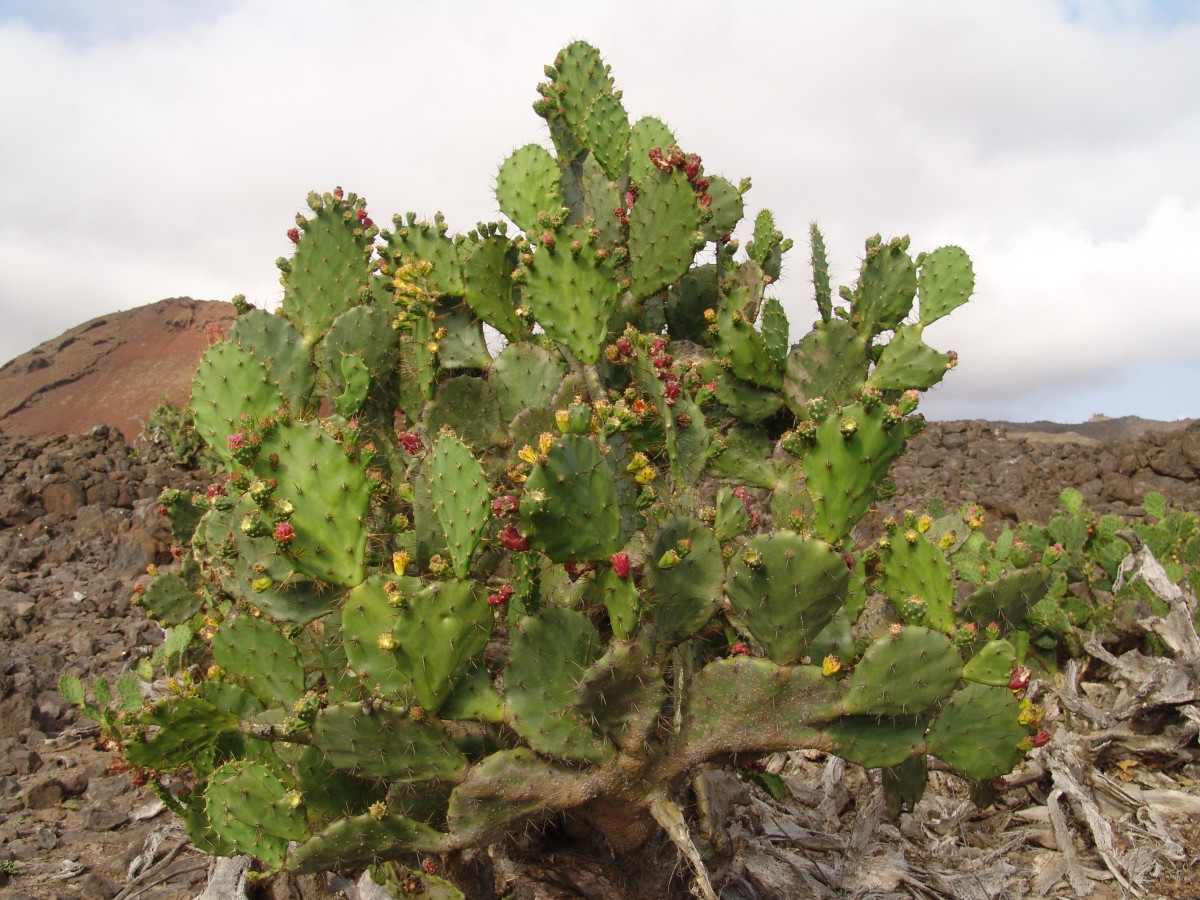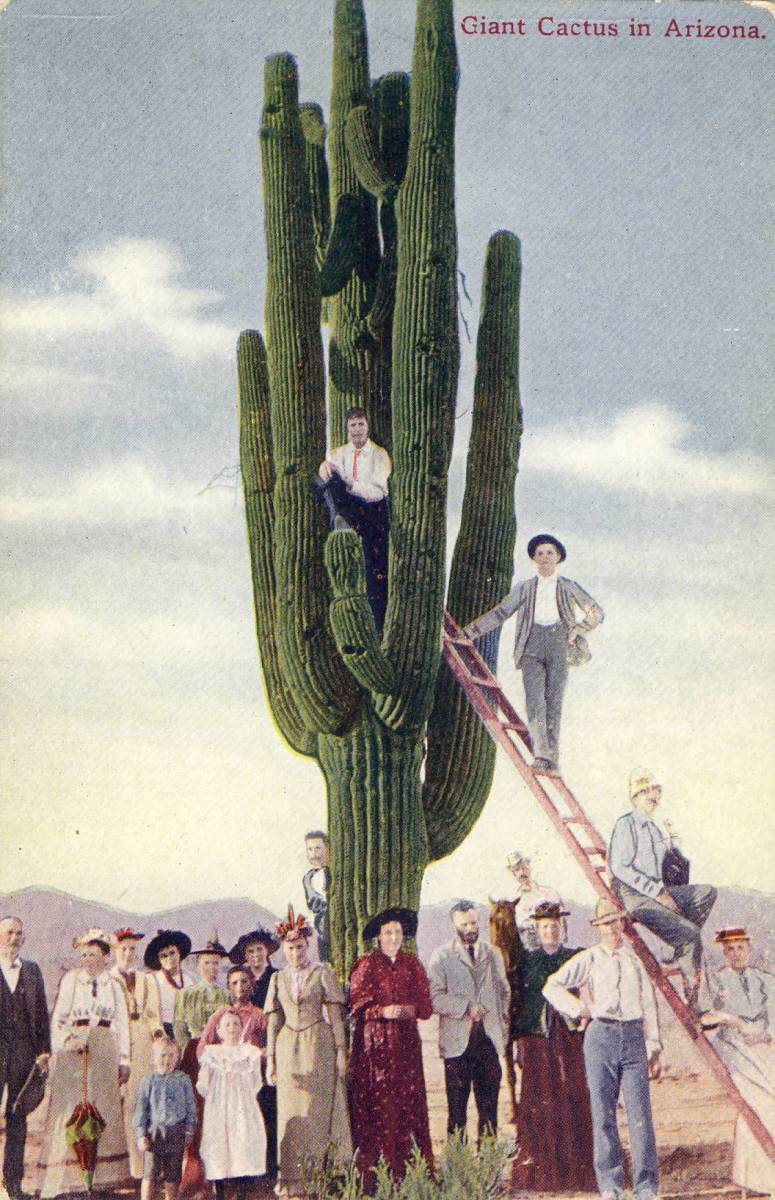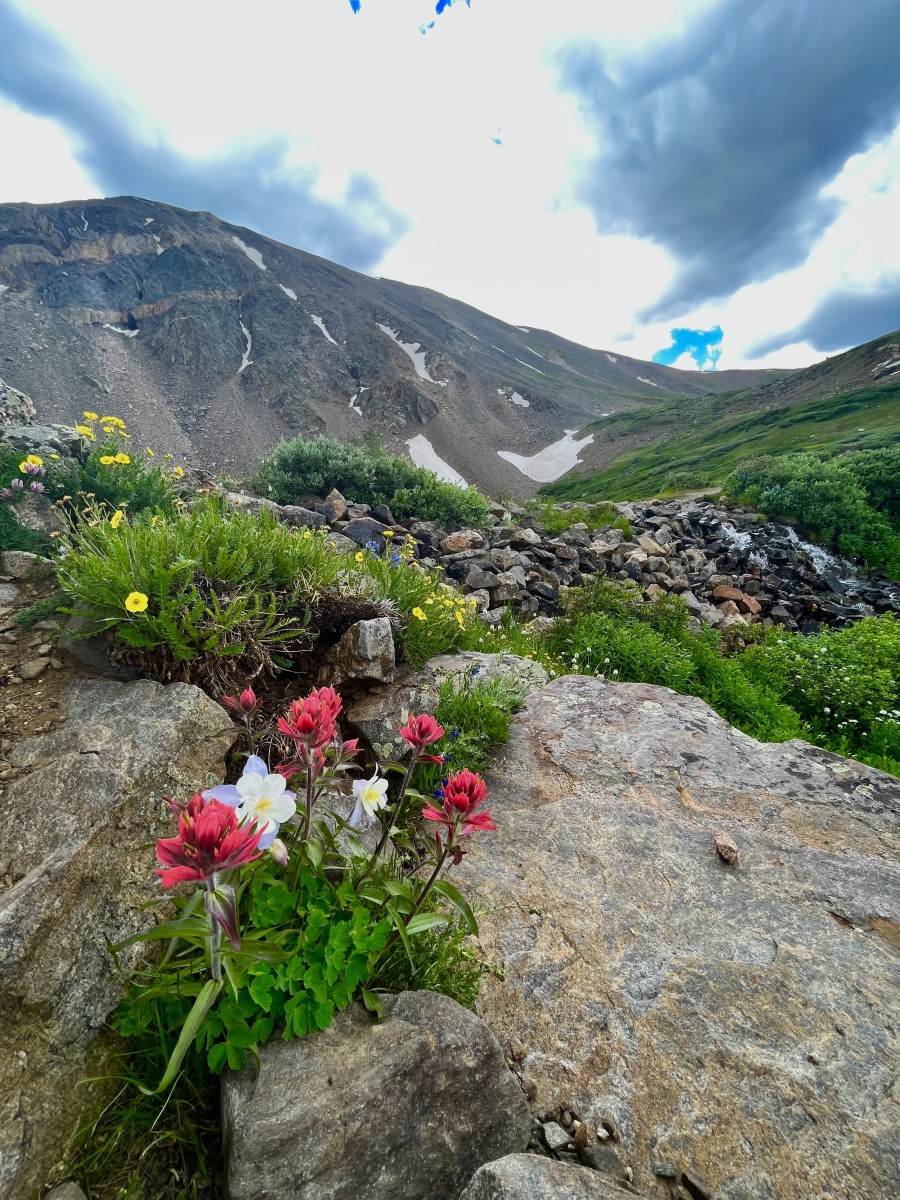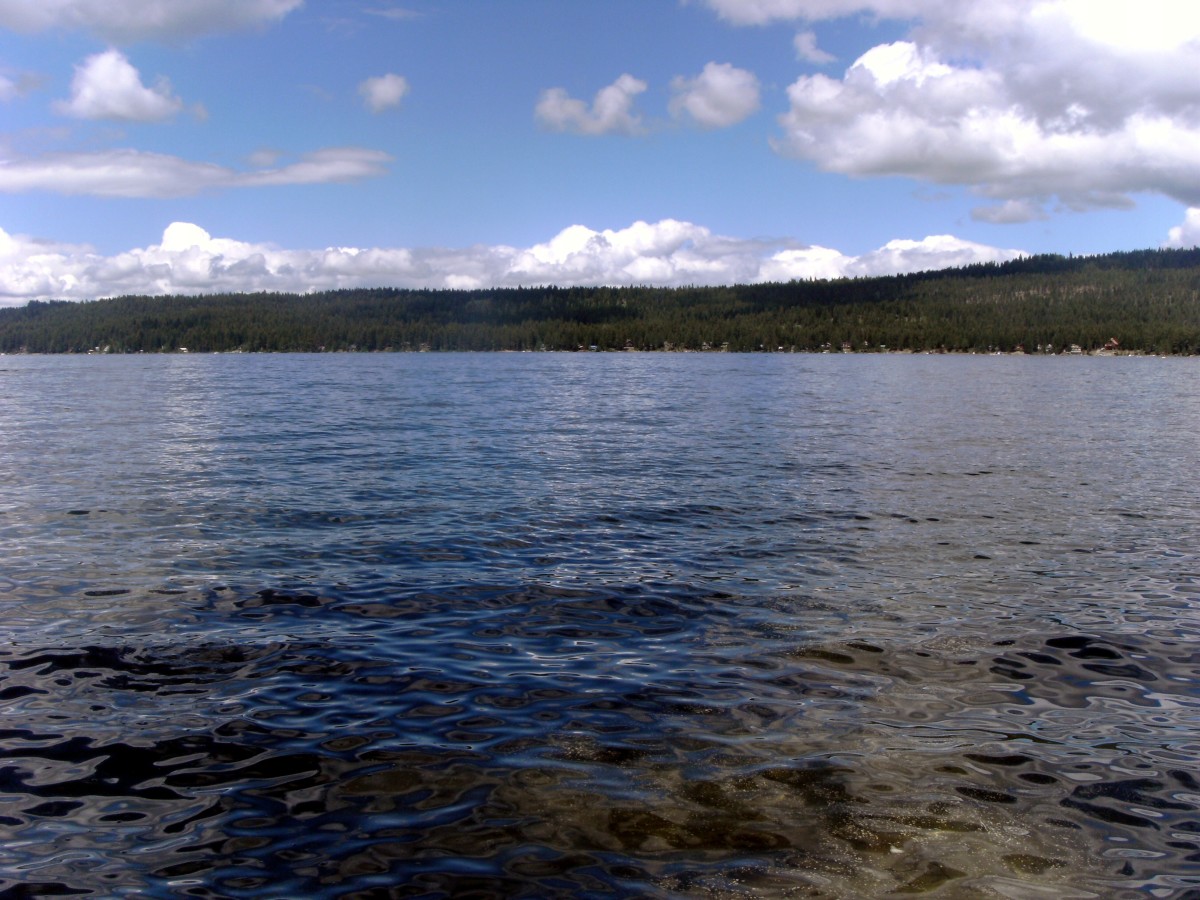Edible Desert
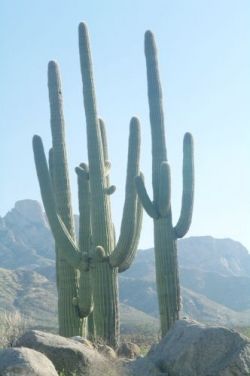
Fresh Food from the Sonoran Desert
While I have heard that there are maybe 50 edible foods in the Sonoran Desert, I think there are more like 450. I share my personal experiences with these foods. Most of them can and should be eaten in the wild, right by the plant where you got the food. Naturally, when you eat desert food out in the wild, still raw, it will be very nutritious and good for you!
The Saguaro cactus (Carnegiea gigantea) is the signature plant of the Sonoran Desert. The fruit is prized by the Tohono O'odham, who harvest it in early July, in a ceremonial way, using saguaro ribs with a small crosspiece to knock the fruit loose. Be sure and get your fruit early, because birds love it!
The fruit contains tiny, crunchy seeds, which are also very good. I like to eat it straight off the cactus if I can get it. The flowers are white, and bloom from late afternoon until morning; they are pollinated by bats. The flower are probably also edible, but I have never been able to retrieve one. When eating a cactus flower, just eat the petals. The fruit is red.
Cactus petals would make good additions to salads, although I eat them straight off the plant. They remind me of rose petals, but they are sweet.
The Tohono O'odham and other local people use it to make jam, jelly, liquor, and probably a few other things.
The fruit of all the native cacti of the Sonoran Desert is edible, though some is insipid.
I am also familiar with a number of medicinal plants, but I will cover that in another Lens.
All photos are mine unless otherwise credited.
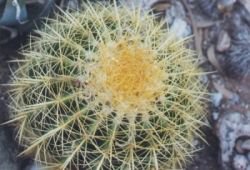
Barrel Cactus
The fruit is edible in its entirety, including the seeds, which are small and crunchy, but not as small as the seeds of Saguaro fruit. When it is green in color, the fruit tastes like limes, and has a slightly firmer texture than a fresh green pepper. When it turns yellow, it tastes like lemon, and retains the texture.
Always try to harvest your food away from roads, to keep it from being covered with auto exhaust.
When I am out hiking and see barrel cactus fruit, I always eat one.
This version is a "Golden Barrel". It is said to be a different species from the common Barrel Cactus that grows around here, but I'm not so sure. After I took this photo, the cactus got taller and lost its golden color. However, I have seen much larger "Golden Barrels" in other people's gardens.
One kind of barrel tends to grow pointing south. It is called a Compass Barrel, and you can use it to help you find your way.
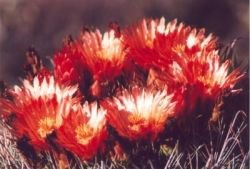
Barrel Cactus Flowers
I will upload a photo of the fruit when I remember to take one. That will be about six months from now. :(
Barrel Cactus is said to be a good source of water in the desert when needed. It is not a certainty that you can get potable liquid from one. You have to cut into it, and let the liquid accumulate in the hollowed center. It is also a good remedy against rattlesnake bite. It is best if you harvest it in advance and let it cure a bit, though the fresh flesh can be applied. It is said in that case, you have to lance the bite for the remedy to work. I have no experience with this, thank goodness!
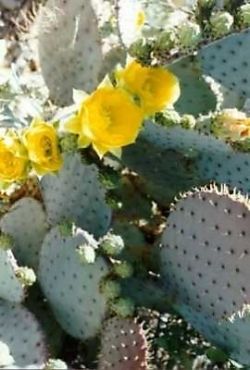
Prickly Pear
Opuntia sp. - Nopales
The variety shown is Opuntia santa-rita. Its pads turn purple when the plant is under stress. Most Prickly Pear stays green. As far as I know, all can be used in the same manner, since all of them are listed as synonyms someplace. The local variety is known as Opuntia engelmannii. They are called Tuna in Spanish.
Prickly Pears have edible fruit. You have to remove the spines from the exterior (which can be done by rubbing the fruit in sand), and then cut open and retrieve the red soft fruit. You have to juice it because it is full of hard seeds. I like the juice straight out of the fruit. People make prickly pear jelly out of it. I can also get punch at the Arizona-Sonora Desert Museum. The fruit is ready to harvest when it turns a dark purple.
The pads are also edible. If you have to harvest mature pads, choose a plant that is standing upright rather than sprawling along the ground. It has to be boiled, and I recommend boiling in three waters with a little salt added. The best pads are the young ones found in spring, which have vestigial leaves instead of true thorns. These are called Nopalitos in Spanish. They also have to be boiled in three waters. Boil in salty water for 10 minutes, drain, add more salty water and boil again, drain, and repeat once more. Before boiling, cut off the "thorns". Slice. After boiling, they can be added to your favorite chili, or mixed with other Mexican foods, such as vegetables, and I think they are quite good. You can often get them in jars in the grocery store.
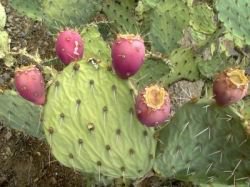
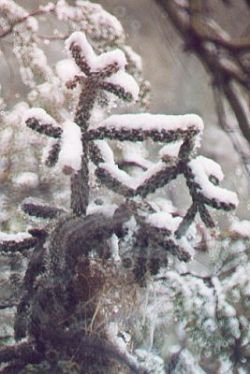
Cholla
Opuntia sp.
Here is something a little different for you: a cactus with snow on it. That's the white stuff. The dark part is the cactus. :)
This plant is classified close to Prickly Pear. It is said to have edible fruit which tastes insipid. It is best eaten roasted. I have never tried it. This is a very common plant where I live. The spines are wicked; be careful if you try to harvest the fruit. Sometimes they occur in chains (one fruit hooked to the one above it, forming a chain of six or seven or more fruits).
Cholla comes in different varieties or species. The difference is in the thickness of the stems, and how long the thorns are. All of them are characterized by cylindrical stems, hence, they were once classified as Cylindropuntia (Prickly Pear was called Platyopuntia).
The spines have little barbs on them, and they seem to be tipped with some kind of nasty stuff that causes a burning sensation. It is important to try to stay away from the plant, but if you get a joint stuck in your skin, use a pliers or a rock to get it out, by grasping or knocking the entire joint.
I once had a terrifying experience. I was out in the desert, and a young barefoot child ran into a Cholla right next to me. She was covered with joints, even on the soles of her feet! Her parents took her to the hospital. I never found out how she did.
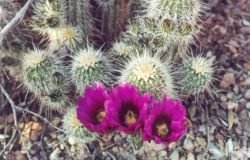
Hedgehog
This is a small cactus with cylindrical joints, that grow from the ground as separate joints. It is a rare plant, so if you harvest it, please plant more.
The flesh has a very nice flavor. You have to peel off the outside, but it can be eaten raw. You should not eat it in winter because it cools the body. The fruit is tiny, and tastes a lot like strawberries. I imagine that's why they call it Strawberry Hedgehog.
Flower color varies. This is one of my favorite colors.
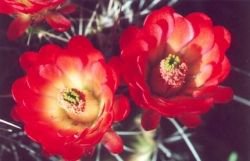
Claret Cup Hedgehog
This species doesn't grow naturally in the Sonoran Desert, but a lot of folks will plant it. They have flowers of a different color. :)
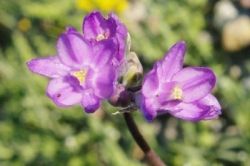
Bluedicks
Dichelostemma capitatum
Bluedicks is basically a wild onion. The corm can be eaten in the same way. This is a spring flower, and they're usually not in large abundance.
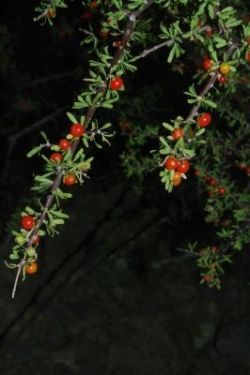
Wolfberry
Lycium berlandieri
The fruit is maybe 1/3 to 1/3 of an inch in diameter in a wet year when they can grow a little larger. They are juicy and tart, and full of antioxidants. They are considered medicinal by the Germans. I agree! I try to get a handful every time I go out when they are in season. Notice how the leaves are small and narrow.
Hackberry fruit is also edible, and about the same size. Unlike Wolfberry, the leaves are pinnate and broad.
Pyracantha is not a native plant, but widely grown in some places. The fruit is edible. You will sometimes see the birds eating it. It can be dry and insipid if it receives no extra watering.
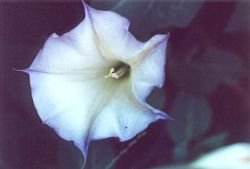
Jimson Weed
Datura meteloides
All parts of this plant are poisonous.
DO NOT EAT IT
The beautiful flowers bloom at night.
Other beautiful but poisonous plants include Lupine and Larkspur.
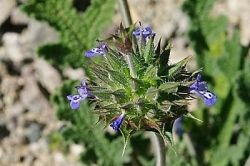
Chia
Salvia columbariae
This is a small plant, which, when in bloom, stands about a food in height. In the desert, only a few blossoms will bloom at a time, maybe 3 or 4.
This is one of the MOST nutritious foods on the planet! Getting enough of it in the desert is somewhat of a problem, because each seedhead contains only a few seeds. But a teaspoon of the seeds makes an excellent survival meal. These can be bought in bulk, but if you are out in the desert in spring, and hungry, you can get them right off the plant. They are loaded with Omega 3 fatty acids (probably the richest source ever), complete protein, natural fiber, and all kinds of other good stuff. I eat them plain, or mix them into a nutritious whey protein drink. You can sprinkle them on things. They don't have a lot of flavor, so they won't affect the taste of what you put them in, but they have just enough flavor to be interesting by themselves. Mostly it's the crunchy texture I like.
If you harvest them directly, gather seedheads into a paper bag, let them dry for a couple of days if possible and necessary, and then separate the seeds by letting them fall to the bottom. They can be winnowed.
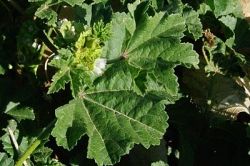
Roundleaf Mallow
Malva neglecta
This is a wonderful salad plant. You eat the leaves. Again, I recommend you make sure and harvest it away from any source of pollution.
We had a wonderful stand of this plant that grew annually, but eventually the London Rocket crowded it out. I was not happy about this, because the Mallow has a much nicer flavor. I like to eat it right off the plant.
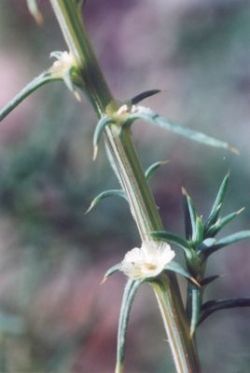
Tumbleweed
Salsola sp.
Also known as Russian Thistle. Must people know what it looks like. I will post a better picture of the whole plant when I get one. This photo shows the tiny flowers of this plant.
Tumbleweed can be harvested when it is young and tender. You boil it like spinach for a short time, and it makes a nice cooked green.
The plant is described more thoroughly at DesertUSA.
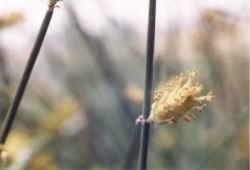
Jointfir
Ephedra sp.
Also known as Mormon Tea. The Mormons made tea from this plant because they were not allowed to drink regular tea or coffee.
It appears as nothing but very long green twigs, with no discernible leaves (anytime I have observed it). You can put a handful of broken twigs in boiling water for a short time. The tea is mild and tastes good. It is said to be mildly stimulant, though I never thought it was. It is just a good beverage tea, and good for the respiratory system. Ephedra contains a pharmacologically active substance that has been used in preparations, but they have switched to a different but similar compound called pseudephedrin. It is marketed under the brand Sudafed, and you have to ask for it at the pharmacy counter. It is not suitable to use for weight loss, contrary to popular opinion.
The photo shows a pollen cone. Jointfir doesn't have a flower as such, just this pollen cone.
For more information on this plant, visit DesertUSA
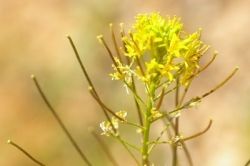
London Rocket
Sisymbrium irio
This is a mustard plant, and the greens will give you a sharp taste in your salad. Use it sparingly. Do not feed it to horses; it can cause kidney trouble. As far as I know, it is safe for humans to eat in moderation. I have eaten it; I just prefer Roundleaf Mallow more.
The thin structures to the side and beneath the flowers are seed pods. The seeds are tiny. In fact, they are much smaller than the seeds normally used in necklaces intended to illustrate the concept of having faith as a mustard seed. If you could gather enough of these tiny seeds, I imagine you could make the traditional condiment mustard from them, but I have never tried it.
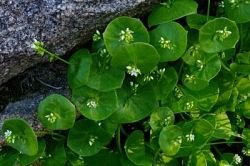
Miner's Lettuce
Claytonia perfoliata
This is a nice salad plant with a mild flavor. It will give you a boost of energy if eaten in the field. I have never found good supplies of it anywhere. It tends to like to grow in the shade of rocks, where it will not get very much sun. I usually find it when I am dead tired and still have to hike back to my car, so it is welcome.
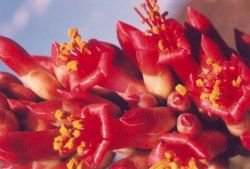
Ocotillo
Fouquieria splendens
Ocotillo flowers are favorites with hummingbirds. You can pick the individual blossoms and suck on them like honeysuckle. I like to pick a bunch of them and put them in a gallon jar, fill the jar with water, and leave it in the refrigerator overnight. It makes a delicate punch. It has to be drunk promptly after 18 hours of steeping in the water, because it begins to go bad after that.
The Ocotillo is a spindly plant, with or without leaves. It is drought deciduous. This means it grows leaves after a reasonable rain, and loses them about a week after it was last sprinkled.
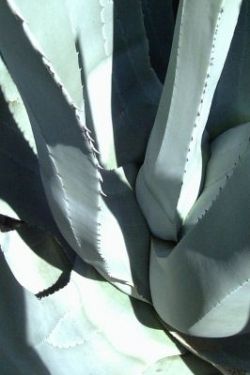
Agave
Agave sp.
There are a number of different species of Agaves. All of them have acrid juice in the fleshy leaves, that can burn the skin badly. In order to be used for food, much processing is needed. The heart is used to make Tequila. It traditionally comes with a worm in the bottle. The worm is real. Tequila is used to make margaritas.
Because the leaves store water, this is known as a succulent. A lot of folks think this is a cactus. It's not. But a cactus is another kind of succulent.
Agave syrup is currently being marketed to use as a sweetener. Please be aware that it is much higher in fructose than even high fructose corn syrup. While it is not harmful in the acute sense, some people will have blood sugar control problems if they get too much fructose. So use it carefully, if you use it. You will have to buy it processed. You can't just go get it from the plant.
They have fields of agave growing in Mexico, that they use to make these products.
This is a closeup view of the leaves.
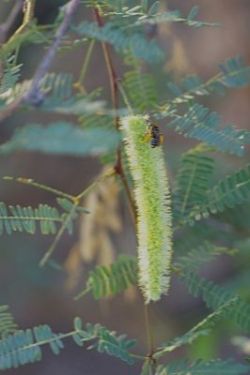
Mesquite
Prosopis velutina
The Mesquite tree grows near underground water. It sends down a deep tap root. The beans can be ground into flour and used to make bread. The flour is very nutritious. There are several different species of Mesquite in the Sonoran Desert.
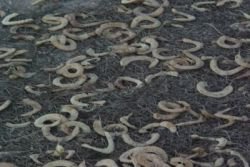
These are seed pods from a Mesquite species, lying on the ground.
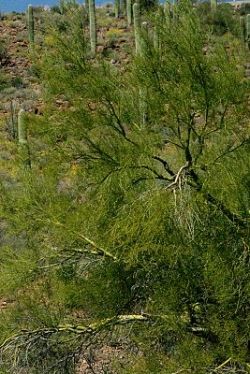
Palo Verde
Cercidium microphyllum
aka Parkinsonia microphylla. The name "Palo Verde" means "green trunk" (well, "trunk green") in Spanish. The plant has leaves only part of the year. There is chlorophyll in trunk and branches, which will make food for the plant.
Palo Verde beans are edible while they are young in early summer, and still green. They taste something like peas, but they're much sweeter and nicer. I eat them straight off the tree. They're encased in a seed pod that takes forever to peel off any quantity of beans, but they are sure good!
Palo Verde flowers are edible but have a weird texture and aren't really tasty.
Books about edible desert plants
These are available on Amazon.
Gathering the Desert
by Gary Paul Nabhan
Includes some lore.
Sonoran Desert Food Plants: Edible Uses for the Desert's Wild Bounty
by Charles W. Kane
I know the author. He is very knowledgeable.
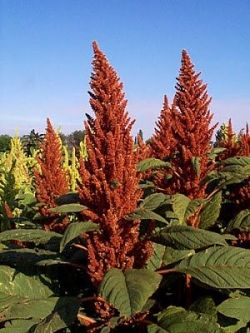
Amaranth
Amaranthus sp.
Amaranth generally grows around August. It is a wonderful grain plant, which has been cultivated for thousands of years. It can also be used as cereal. It can be bought in health grocery stores. It is free of gluten.
Image is licensed under Creative Commons attribution, no commercial, no derivatives, by Yann Chef. The local species is not as thick as this one; the plant and the seed clusters are considerably smaller.


